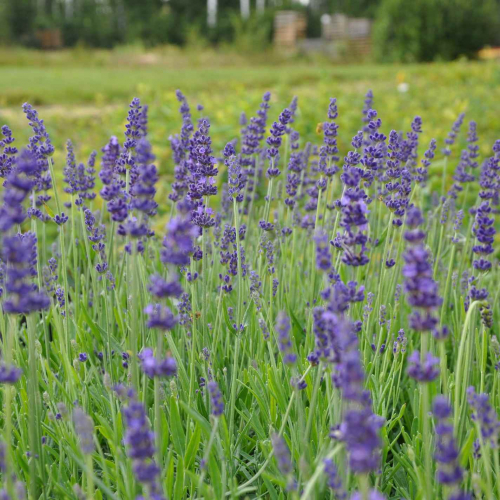Perennials Lavandulа

Description
Characteristic Features of Lavender
Lavender (Lavandula) is genus of perennial evergreen shrubs and dwarf shrubs in the family Lamiaceae or Labiatae. In the wild, Lavender is found in the Canary Islands, Europe, India, and the Mediterranean and is cultivated extensively all over the world.
The name of this plant can be traced back to the Latin "lava" (to wash). This refers to the fact that Lavender was added to bathing water since ancient times. To this day, the essential oil of this beautiful plant is widely used in cosmetics, perfumery, and medicine. Since the Middle Ages, because of its persistent fragrance, Lavender has been used to repel moth. Currently in some countries, especially Spain, Italy, and France, Lavender is grown not only as an ornamental and medicinal plant but also as a spice.
According to an ancient legend, the incredible fragrance was given to the plant by Virgin Mary in gratitude for the fact that Jesus' clothes was drying on a lavender shrub. The plant is believed to repel evil spirits.
Lavender reaches a height of 50-70 centimetres. The root is branched and goes down 4 metres deep. The stems are upright. The leaves are linear, greyish green. The fragrant flowers are typically purple, blue, blue, or lilac and collected in spikes. The fruit is an achene consisting of four parts in a cup and containing about 1000 seeds per gram.
Lavender contains essential oils, tannins, resins, and bitterness.
In landscaping, Lavender shrubs look great at patios, in rockeries, flower borders, and mixed borders. The best companions are roses, santolinas, and other yellow-flowered plants. Low-growing varieties are grown in containers.
The Lavandula genus contains about 30 species.
English Lavender (Lavandula angustifolia) is native to the Mediterranean. This shrub grows to a height of 70 centimetres and has narrow leaves and hairy grey-green leaves and purple, lilac, or blue flowers that bloom in mid-summer.
Lavandula x intermedia is an ornamental hybrid with greyish leaves and quite large flowers that can be white, purple, blue, or lilac depending on the variety.
Lavandula dentata is a heat-loving plant native to the Mediterranean. This species has greyish leaves with toothed edges and large flowers that bloom in mid-summer.
Lavandula lanata is a plant native to Spain that is noted for its leaves with pronounced woolly hair.
However, the most commonly cultivated species are Lavandula latifolia and Lavandula officinalis.
Broadleaved Lavender (Lavandula latifolia) is mostly grown in France for oil. This species is quite heat-loving and is grown less frequently in moderate climates. Broadleaved Lavender has strikingly beautiful flowers of various colours from indigo to white to greenish. Flowers are borne from mid-spring until the second half of the summer. In the beginning of autumn, the plant frequently reblooms. The most popular varieties are 'Papillon' (butterfly-shaped flowers), 'Tiara' (blue flowers with beige bracts), and 'Regal Splendour "(deep purple flowers).
Lavender also contains medicinal essential oil. Ever since the 13th century, the plant has been used in medicine to treat numerous diseases. Dried flowers are often used to add unique flavour to tea. Lavendula officinalis grows 50 centimetres tall, has grey green leaves and beautiful purple flowers.
In the floriculture, Lavendula officinalis var. Deiphinensis is very popular. It grows to about 30 centimetres tall and has ornamental silvery leaves.
The Secrets to Successfully Growing Lavender
The plant does best in sunny locations with dry lightweight soils. Sandy clay, limestone, or gravel soils are suitable. Avoid high acidity and waterlogging. An important condition for the successful growing of the plant is good drainage. Lavender does not have any other specific requirements.
The basic care includes abundant watering during drought periods, weeding of young plants, loosening the soil, proper pruning in the spring (cut old stems by one-third), deadheading, and winter sheltering with spruce branches in unstable cold climates. The plant can only withstand temperature drops down to -25 ° C. Use potash fertilizers every spring. Lavender can grow in the same location for about seven years.
Lavender can be propagated from seed. After one-month stratification, sow the seeds in February or March 3-5 millimetres deep and allow germinating in the light at 20 ° C. Prick out seedlings once they have two or three leaves and plant out in May, spacing at least 30 centimetres apart. The plants grown from seed will bloom on the 2nd or 3rd year.
Propagation by cuttings is also possible. Cut one- or two-year-old shoots without flowers into cuttings of about 10 centimetres long and plant in a propagation case. About two months later, plant them out to a permanent location.
Experienced growers sometimes propagate Lavender by layering. In the spring or autumn, bend 2 or 3 shoots down to the ground, pin them down in a small hole, cover with soil, and water. The following spring, the shoots can be cut off from their parent plant.
The easiest way to rejuvenate Lavender is dividing the shrub in the autumn. The plant can be easily dug out and divided into parts that will develop into young plants in the spring.
Potential Problems
Failure to comply with basic care requirements may result in root rot. At the first sign of the disease, immediately remove and burn the affected parts and treat the plant with fungicide.
Lavender is sometimes attacked by the spittlebug. The pests lay their larvae on plants and develop foam. Though Lavender does not suffer, it looks unsightly. Wash the spittlebug larvae off with water. Lavandula latifolia and Lavandula dentate can be affected by the iridescent beetle that must be removed manually.







 5 350
5 350







